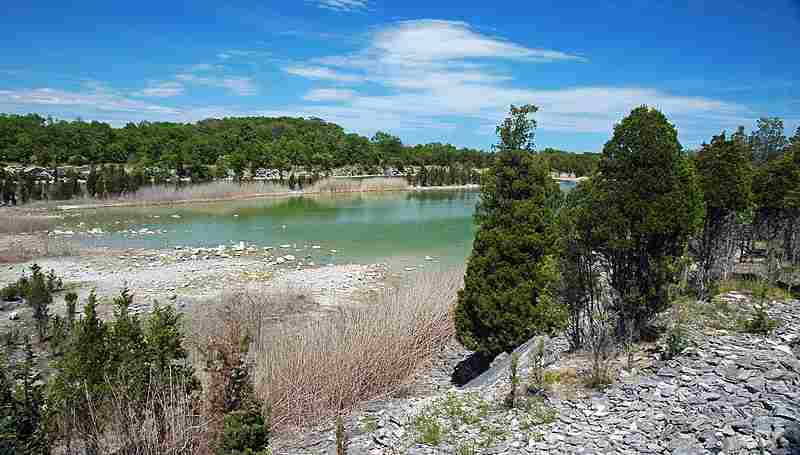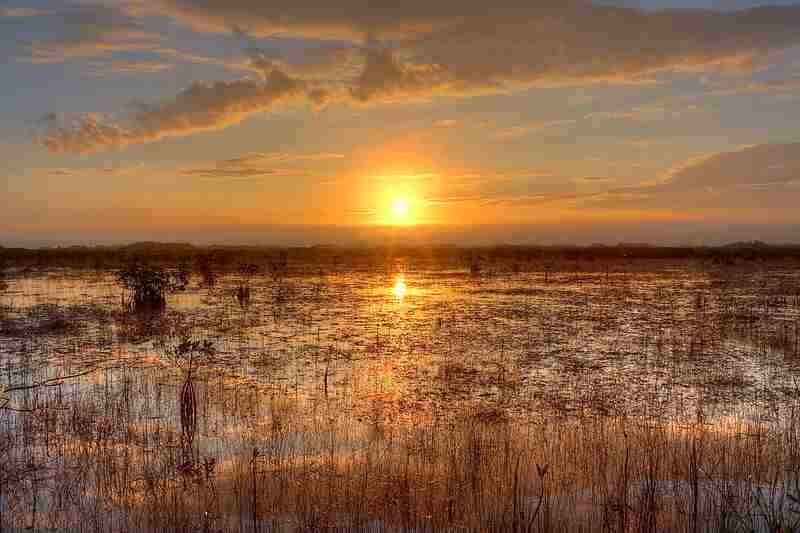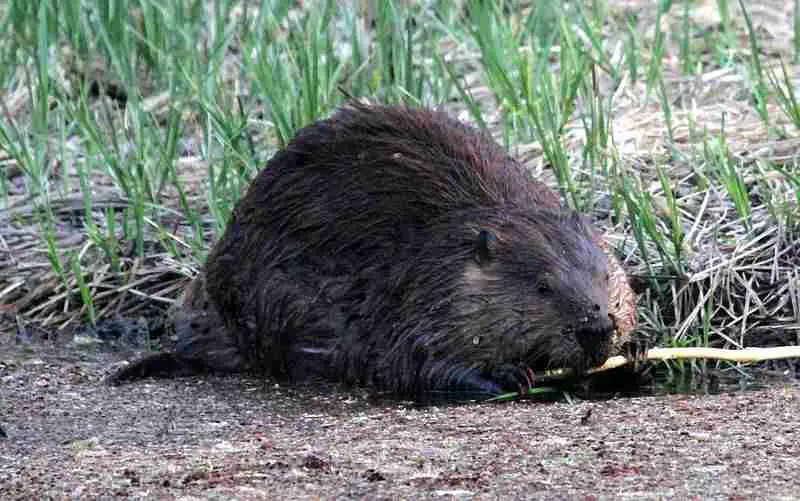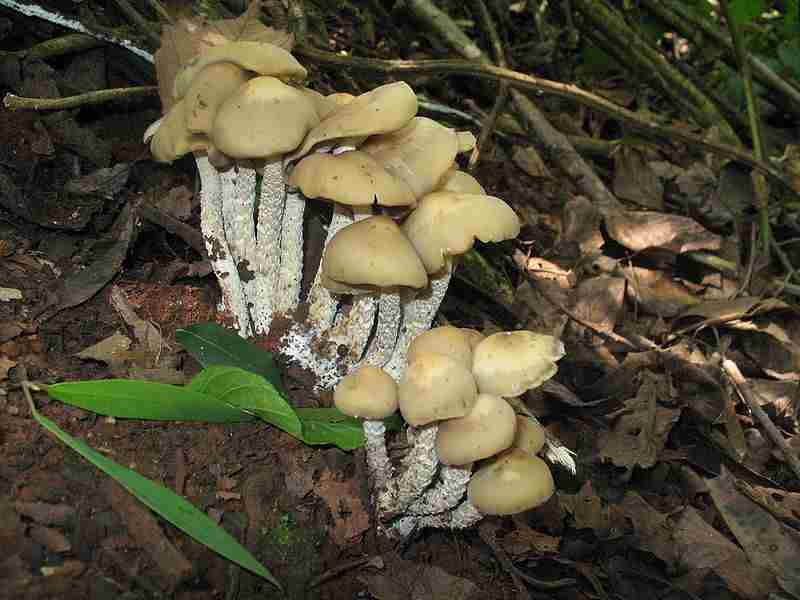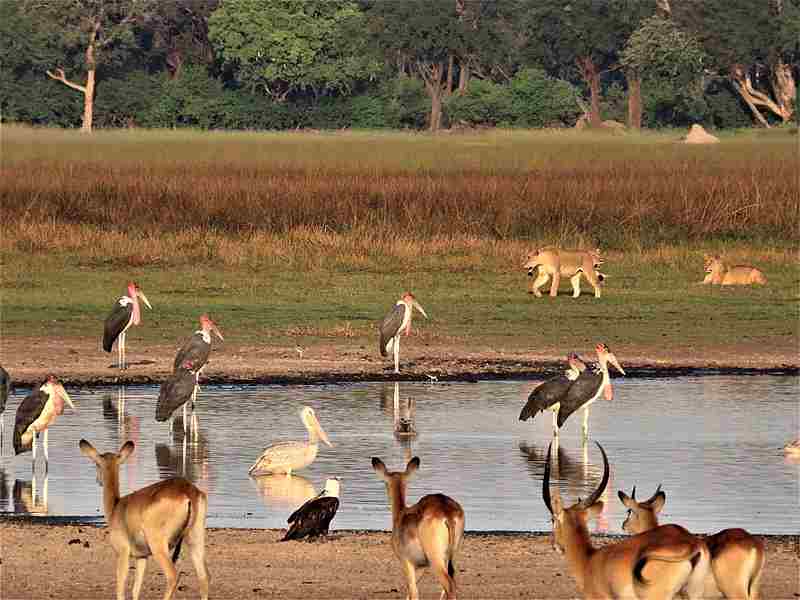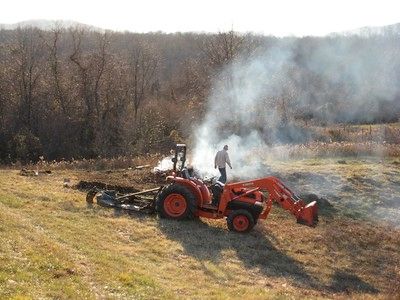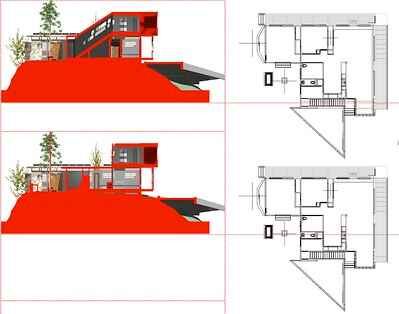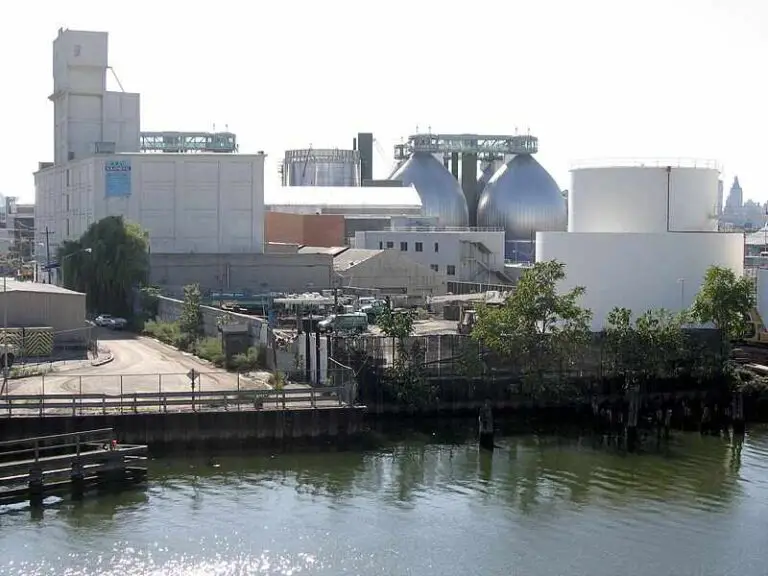11 Characteristics of Wetlands and Their Ecologic Implications
Characteristics of wetlands are; autotrophic dominance of hydrophytes, saturated hydric soil, seasonal flooding, minimal weather variation, high surface-hydraulic conductivity; geographic differences in vegetation, high carbon sequestration capacity, geographic differences in water salinity, well-adapted biodiversity, transitional possession of both aquatic and terrestrial attributes.
This article discusses the characteristics of wetlands, as follows;
1). Autotrophic Predominance of Hydrophytes (as one of the Characteristics of Wetlands)
Hydrophytes are a group of plants that are well-adapted for survival in aquatic environments, especially in wetlands, where they are known to thrive with their roots submerged in water or highly-saturated soils [13].
They demonstrate autotrophic predominance in the wetland ecosystem; meaning they are (one of) the most dominant primary producers in wetlands, being capable of producing their own food through photosynthesis. This characteristic allows them to take advantage of abundant sunlight and access to nutrients available in the aquatic environment.
Characteristics of Hydrophytes
Characteristics of hydrophytes include possession of floating leaves or stems, aerenchyma tissues, reduced stomata and cuticle, as well as extensive root systems.
Floating (spongy) stems or leaves occur in many hydrophytes, as an adaptation to enable them stay on the surface of water
This feature can be observed in plants like water hyacinth (Eichhornia crassipes) and water lilies (Nymphaea spp.) among others, allowing them stay buoyant and capture maximum solar radiation (sunlight) for photosynthesis.
Aerenchyma tissues are another specialized feature occurring in hydrophytes.
These tissues provide air spaces in the plant's structure, and increase the efficiency of oxygen transport to the submerged rhizomes and roots, in such a manner that enhances the plants' ability to respire in saturated or waterlogged conditions.
The leaf-stomata and cuticles of some hydrophytes are reduced; an adaptation which is meant to enable the plant achieve water conservation by minimizing the rate water loss from their leaves.
This adaptation is helpful for preventing water stress and excessive transpiration in the submerged environment.
Extensive root systems also occur in hydrophytes, allowing them to anchor firmly in the muddy, soft substrate of wetland habitats, while efficiently absorbing nutrients from the surrounding sediments and water.

A typical characteristic feature of hydrophytes is their tolerance, or even requirement, of prolonged conditions of waterlogging or inundation [16]. This adaptation enables the plants to reproduce and grow successfully in aquatic terrains.
*Overview of Ecological Adaptations and Characteristic Features of Hydrophytes
The ecological adaptations of hydrophytes are equivalent to their characteristic-features, and include floating adaptations, aerial roots, air cavities, and low light-intensity tolerance.
Floating adaptations in hydrophytes can be traced to stems and/or leaves that have evolved this feature in order to maximize solar capture-efficiency through exposure to sunlight for photosynthesis.
Aerial roots occur in some hydrophytes, such as mangroves (Rhizophora spp.) [11].
These roots are emergent, reaching above the water's surface, and they facilitate gas exchange with the atmosphere while providing support in unstable soft sedimentary substrates.
Air spaces are provided in aerenchyma tissues within hydrophytes play, which a critical role in nutrient transport, gas exchange and buoyancy. These air spaces create a natural mechanism of floatation that enables hydrophytes to remain buoyant in water.
Hyrophytes submerged in water, are generally adapted to low light-intensity conditions.
Some features that enable them thrive in spite of low light intensity include elongated stems, thin leaves, and high-conversion pigments. These features work together to reduce light absorption constraints and ensure that their photosynthetic capabilities remain efficient even in the absence of sufficient light.
*Overview of Plants' Adaptations to Wetlands
Plants in wetlands have evolved multiple adaptations in order to survive in their unique habitats, which include; water-saturation tolerance, minimal transpiration, specialized roots, and enhanced nutrient uptake. They are outlined concisely below;
Ability to tolerate submerged, flooded or waterlogged conditions through aerenchyma floatation mechanism and specialized root systems.
Reduced rate of transpiration through modified leaf structures, such as reduced stomata and cuticles, for conservation of water especially under conditions of high salinity and/or seasonal water level fluctuation/resource depletion.
Formation of pneumatophores or adventitious roots for oxygen uptake in deoygenated (low-oxygen) soils [17].
Enhanced mechanism of nutrient uptake through extensive root systems that scavenge and absorb nutrients efficiently from the sedimentary substrate, and water.
2). Poor Regional Drainage
Poor regional drainage in wetlands is a the natural condition where water flow is restricted or slow, resulting in the accumulation of water within the area.
Wetlands are characterized by their saturated or waterlogged conditions, which are caused by multiple factors such as low regional gradient, flat topography, and the presence of impermeable subsurface rocks or soils that impede water percolation/infiltration and drainage.

Overview of the Meaning of Wetland Drainage
Wetland drainage means the natural (or anthropogenic) removal of excess water from wetland areas either through infiltration, or through the construction of ditches and drainage systems, among other mechanisms.
It must be noted that wetland drainage is often an anthropogenic or human-induced process, because of the naturally-poor drainage of this ecosystem.
It is often done to in order to convert wetland areas into navigable dry land for human purposes like urban development, and agriculture [5].
Although wetland drainage may be carried out for economic benefits, it can also have severe environmental consequences, as it negatively impacting the ecological functions, and local biodiversity of wetland ecosystems; while placing adjacent areas at risk of hydrological hazards like flooding, especially where the wetland is directly connected to a larger aquatic ecosystem.
Proper consideration of wetland management and conservation criteria, is important to avoid the potentially-adverse economic and environmental impacts of wetland drainage.
Disadvantages of Wetland Drainage
Disadvantages of wetland drainage include; biodiversity loss, water quality impacts, flood risk, contribution to climate change, and increased erosion potential. They are discussed below;
Wetlands are dynamic ecosystems that support a wide and unique variety of animal and plant species. When these wetlands are drained, several of these species lose their habitats, resulting in a decline in local biodiversity and increased risk of extinction, of certain species.
Impacts on water quality are another disadvantage of wetland drainage.
This is because wetlands act as natural filtration systems, that remove excess nutrients and suspended pollutants from water [4]. Drainage of wetlands causes the loss of these essential water purification functions, and can lead to increased pollution in water bodies that occur downstream of the wetland zone.
In addition to their water filtration function, wetlands serve as natural buffers for flood or stormwater, by absorbing and retaining excess water during heavy rainfall and storm events. This implies that wetland drainage will reduce their ability to mitigate regional flooding is diminished, contributing to more frequent and severe flood events in the surrounding areas.
Carbon sequestration is a role of wetlands, which are known as efficient and effective, long-term carbon sinks wherever they naturally occur [18].
Wetlands help to mitigate global warming and climate change by trapping and sequestering carbon dioxide. The drainage of wetlands can release stored carbon and increase greenhouse gas emissions, which in turn exacerbate climate change.
Erosion risk is also increased as a result of wetland drainage in many cases.
Wetland soils and vegetation help stabilize shoreline areas and prevent erosion [6]. Drainage can eliminate this function and lead to increased erosion with the loss of valuable shoreline and coastal habitats.
3). Saturated Hydric Soil (as one of the Characteristics of Wetlands)
Saturated hydric soil is a characteristic feature that occurs in wetlands, and contributes immensely to the anaerobic and waterlogged conditions of these ecosystems.
Hydric soil is typically water-saturated for a significant portion of the growing season, which results in low oxygen levels within the soil profile.
This unique soil condition is a key distinguishing factor that differentiates wetland soils from soils in upland areas.
Characteristics of Hydric Soil in Wetlands
Characteristics of hydric soil in wetlands include; water saturation, anaerobic conditions, high organic composition, low permeability, and intrinsic oxygen-reduction reactions. They are discussed below;
Saturated hydric soil in wetlands remains inundated or waterlogged for a significant period of time, especially during the growing season.
Anaerobic conditions are common as a result of the lack of oxygen in the pore spaces of waterlogged hydric soil.
This leads to the evolution of specialized microbial communities that thrive in anaerobic, low-oxygen environments.
Dark organic layers in hydric soils are often called muck or peat, and are composed of partially decomposed plant biomass.

Reduction reactions lead to the development of some observable reduction features in hydric soils, such as gleying or grey mottling, which are caused primarily by lack of oxygen in the soil.
Low permeability is another typical characteristic of hydric soils, which implies that they do not permit rapid, effective or efficient drainage of water, thereby contributing to the waterlogged conditions.
Soil Composition in Wetlands
The composition of wetland soils includes various materials, such as heavy metals, organic matter, water, quartz, feldspar, calcite, weathered clay minerals, and dispersed rock fragments.
The particle sizes in wetland soils include sand, silt, and clay [15]; while the organic matter mainly comprises metamorphosed peat, and partially decomposed plant debris.
Soil Quality in Wetlands
Soil quality in wetlands is relatively high, as the soil is often very fertile due to the presence of significant quantity of organic matter.
The anaerobic, waterlogged conditions for most of the year provide a degree of stability that allows the soil to capture and retain nutrients and organic carbon.
Soil quality in wetlands is a critical factor for the maintenance of species richness, biodiversity and ecological functions of these ecosystems.
Wetland soils have essential roles to play in water filtration, nutrient cycling, and provision of habitat for various animal and plant species. The maintenance of healthy soil conditions is therefore necessary to support the diverse array of life that occurs in wetland terrains.
Hydric Soil Classifications
Hydric soils are classified based on their intrinsic and extrinsic (or conditional) characteristics, including texture, color, redoximorphic features, geographic location, and evolution mechanism(s).
The hydric soil classification system by United States Department of Agriculture (USDA) is commonly used for wetland management and delineation.
Some of the main hydric soil classes in this scheme include; gelisols, histosols, inceptisols, spodosols, and oxisols. They are discussed below;
Gelisols are associated with cold climates, and often overlie permafrost as a result of prolonged seasonal freezing.
Histosols are soils that are rich in organic matter, and may be referred to as muck or peat soils.
Inceptisols are juvenile soils with weak development, which are commonly found in wetlands with temporally-variable conditions of drainage.
Spodosols are acidic soils that typically occur in sandy or forested wetlands [8].
Oxisols are highly weathered soils that can occur in some tropical wetland areas.
4). Seasonal Flooding
Seasonal flooding is a characteristic feature of several wetland regions, where water levels fluctuate in response to snowmelt and seasonal precipitation changes.
During the wet season, these areas typically experience a rise in water levels, which results in inundation of the landscape.
On the other hand, the dry season features a recession in water levels, so that the wetland may even become dry for a period of time.

Definition of a Seasonal Wetland
A seasonal wetland, also known as a temporary or seasonal pond/pool, is a type of wetland that is subject to cyclical changes in water levels throughout the year.
Seasonal wetlands are most common in regions with distinct dry and wet seasons, such as tropical and temperate climatic zones.
Seasonal Pattern of Water Level in a Wetland
The seasonal pattern of water level in a wetland is predictable, cyclic and repetitive; being driven by sedimentary, hydrological and weather conditions.
During the wet season, which may coincide with summer or spring, increased snow-melting and precipitation cause water levels to increase. This inundation period facilitates the development of temporary aquatic habitats that support various aquatic animals, plants, and sub-terrestrial wildlife.
As the dry season approaches, processes like runoff and precipitation tend to reduce in frequency and intensity, in turn leading to a decline in regional water levels. During this period, wetlands may comprise of isolated pools/water pockets, or may appear dry.
Many aquatic plants and animals that inhabit seasonal wetlands have adapted to these fluctuations and are able to tolerate them, with some species laying dormant eggs or producing seeds during dry periods, which germinate or hatch only when water levels increase.
Seasonality of Wetlands
The seasonality of wetlands is simply the sum-total of cyclic changes in hydrological conditions that occur in these areas over the course of a year.
This seasonality plays a major role in shaping the ecological dynamics and physical features of wetland ecosystems.
The alternate dry and wet phases influence the distribution of animals and plants, affecting their migratory behaviors and reproductive strategies.
Seasonal wetlands provide essential foraging and breeding grounds for numerous organic species, including insects, waterfowl, amphibians, migratory birds and waterfowl. They serve as important hosts of biodiversity and contribute to regional flood control, nutrient cycling and water purification.
5). Minimal Weather Variation (as one of the Characteristics of Wetlands)
One of the characteristics of wetlands is minimal weather variation compared to surrounding upland zones.
This is due to the unique physical and hydrological properties of wetlands, which work together to create relatively-consistent and stable environmental conditions.
Some key factors that contribute to minimal weather variation in wetlands include; water retention, evaporative cooling, wind-breaking, seasonal water buffering, shading and microclimate creation. They are discussed summarily below;
Wetlands have relatively high water-holding capacity [2], and the presence of water plays a role in temperature regulation since water is a conductive medium that is capable of thermal energy transfer, convection and absorption.
Water tends to absorb and release heat at a slower pace than land, which leads to milder temperature variations in wetland environments.
Evaporative cooling is another physical process that occurs in wetlands.
The evaporation of water from sediments and flood within wetlands, has a cooling effect on the surrounding air, and helps maintain relatively cool temperatures in contrast to unsaturated areas.
Wind reduction is achieved by dense vegetation in many wetlands, which acts as a barrier to the flow of air currents and wind, so that wind speed is reduced along with potential, rapid changes in temperature that are caused by wind chill-effects.
Seasonal water buffering by wetlands has to do with their role as natural water reservoirs that reduce the effects of extreme hydrological conditions like excessive rainfall and drought.
Their high water storage-capacity helps maintain a more stable, regional hydrological regime, which in turn stabilizes weather patterns within the wetland area.
Dense vegetation in many wetlands also provides shade, and reduces direct exposure to sunlight, so that temperature extremes are minimized.
Microclimatic conditions are often created in wetlands due to the interaction between flat land, sediments, water, and vegetation. These microclimates also contribute to the stability of weather conditions in the wetland.
How Wetlands are Adapted to Climate Change
Wetlands are adapted to climate change through environmentally-induced shifts in sedimentary make-up, hydrological capacity and organic features.
Wetlands are crucial for mitigating the impacts of climate change. As climate change results in higher frequency of extreme weather events, such as storms, droughts and floods, wetlands can act as natural buffers that provide ecological resilience to natural habitats and human communities.
Their water retention functions, help reduce the severity of regional flooding, by absorbing excess stormwater during heavy rainfall.
During droughts, wetlands often release stored water to sustain the availability and flow of hydrological resources in adjacent streams and rivers.
In addition, wetlands sequester significant amounts of carbon, and help to mitigate climate change by functioning as carbon sinks. Restoring and preserving wetland ecosystems, enhance their ability to adapt to changing climate conditions and contribute to the mitigation of global climate change.
Six Characteristics of a Marsh Habitat/Environment
Characteristics of a marsh are; shallow water, saturated soil, low hydrological flow/poor drainage, significant nutrient availability, diverse wildlife, and emergent vegetation. They are discussed below;
Typically, marshes are shallow-water ecosystems [14], with variations in water depth occurring throughout the year, in response to seasonal changes in water availability and recharge rates.
Waterlogged, saturated soil is also a core characteristic of marshes, and leads to reduced oxygen levels on a regional scale, which favor the growth of microbes and plants that are adapted to anaerobic conditions.
Standing water with low flow dynamics is common in marshes, which may be described as ponds or pools, and serve as habitat for specialized aquatic species as well as other water-dependent organisms.
Nutrient-rich conditions are typical of marshes, because they receive nutrients from adjacent water sources and terrestrial areas. This abundance/high availability of nutrients often supports diverse food chains/webs and dense vegetation.
Marshes often support a wide and diverse variety of wildlife, which includes amphibians, insects, reptiles, mammals and birds. They serve as important sites for foraging and breeding, for numerous species.

Emergent vegetation is fairly dominant in marshes, and may include reeds, sedges and typical grass species. These plants usually possess specialized adaptations for thriving in humid, shallow water regions.
6). High Surface-Hydraulic Conductivity
Surface-hydraulic conductivity can be defined as to the ability of a material or body, such as a mass of sediments or soil, to transmit water horizontally across its surface area.
Within the context of wetland ecosystems, a high surface-hydraulic conductivity implies that the wetland's surface permits relatively-rapid and unhindered flow of water across it, in such a manner that promotes efficient water movement, and drainage.
Factors that Indicate and Foster High Surface-Hydraulic Conductivity in Wetlands
Factors associated with high surface-hydraulic conductivity in wetlands include; rapid water flow, permeable surface soil, and reduced surface-ponding.
Rapid (surface) water flow is an outcome high hydraulic conductivity, which allows water to flow relatively-quickly across the wetland's surface, and often augments the overall low drainage of wetland soils especially in heavy rainfall events.
Permeable soil on the surface of wetlands is caused by loosing of sedimentary masses and widening of interconnected pore spaces by water. This also allows water to easily infiltrate to a shallow depth, and move horizontally with little resistance.
The occurrence of peat, clay and carbonate materials reduces this permeability at depths below the surface, resulting in overall poor drainage.
Reduced surface ponding occurs in wetlands with high surface-hydraulic conductivity compared to others with less hydraulic conductivity at the surface, because water is absorbed and allowed to flow through the topsoil.
Waterlogging is not too severe in wetlands with particularly high surface-hydraulic conductivity. This reduces oxygen deprivation and promotes healthier growth of plants.
How Hydraulic Conductivity Affects Groundwater
Hydraulic conductivity affects groundwater through its influence on the flow, percolation and infiltration of water across or through the surface or cross sectional area of soil and rock materials. This influence plays a role in groundwater recharge, discharge, and quality.
In the context of wetlands, hydraulic conductivity has multiple implications for groundwater flow and storage. Some of the ways in which hydraulic conductivity affects groundwater (in wetlands) are discussed briefly below;
Groundwater recharge in wetlands is often influenced by conditions of high surface-hydraulic conductivity, which allow rainfall and surface runoff to infiltrate the soil, percolating gradually into the underlying aquifers.
In some cases groundwater from aquifers can discharge into wetlands [9]. This phenomenon is particularly pronounced where hydraulic conductivity on the surface is high, and contributes to the wetland's water supply, as well as the maintenance of stable water levels.
Groundwater quality is also influenced by hydraulic conductivity, because the flow of water through soil affects the transport of contaminants and nutrients. A high hydraulic conductivity can facilitate faster movement of water and associated substances, and potentially influence the quality of groundwater.
Wetland health and functionality are impacted by the ability of wetlands to maintain high surface-hydraulic conductivity. Relatively efficient drainage can help mitigate the severity of waterlogging and its anaerobic consequences, creating suitable conditions for the survival of diverse animal and plant species.
7). Geographic Differences in Vegetation (as one of the Characteristics of Wetlands)
One of the noticeable characteristics of wetlands is the difference in vegetation types/species structure, from one geographic region to another.
Wetlands are diverse ecosystems which occur in various geographical locations around the world. The composition and spatial distribution of vegetation in wetlands can vary significantly based on different factors including geographical region, hydrology, topographic details, soil type, and local climate.
Some of the characteristics of wetland vegetation in different geographic regions are highlighted below;
1. Tropical wetlands are characterized by dense and lush vegetation. They often include a variety of mangroves, palm trees, and ferns, among other tropical plant species.
These wetlands provide important microhabitats for a diverse array of wildlife, including reptiles, amphibians and birds.

2. Wetlands in temperate (deciduous) regions are often dominated by numerous types of rushes, sedges and grasses.
Trees like alders, maples and willows are also fairly common in temperate wetlands [7]. These wetlands are important feeding and breeding sites for migratory birds, and also support diverse terrestrial and aquatic species.
3. Boreal regions play host to wetlands which may consist of coniferous trees such as pine and spruce. These wetlands feature highly-organic, anaerobic peatlands, and are effective for both water regulation and carbon storage.
Wetlands in boreal regions create habitat for various unique, cold-adapted species including waterfowl.
4. Coastal wetlands, including salt marshes and mangroves, occur along coastlines around the world. These wetlands are uniquely adapted to the saline conditions under which they evolved, and several halophytic plant species such as saltmarsh cordgrass, and mangroves.
5. Wetlands in high-altitude regions, are influenced by the typical conditions of mountainous terrains. These wetlands, often called alpine or montane wetlands, may include bog-like formations with specialized, adapted and cold-tolerate vegetation.
6. Various geographic regions play host to peatlands, which are a type of wetland characterized by massive accumulation of partially-decayed organic materials, referred to as peat. Peatlands often are inhabited by unique vegetation adapted to waterlogged and acidic conditions.
Geographic Distribution of Wetlands
Wetlands occur on every continent on Earth except Antarctica, where they are generally ephemeral, unprotected and unrecognized [10].
Factors that influence the geographic distribution of wetland locations, include topography, hydrology and climate.
Some of the largest wetlands in the world include the Pantanal in Brazil, Amazon Basin in South America, Okavango Delta in Botswana, and the Everglades in the United States.
Wetlands can be found in both saline and freshwater environments, from lowlands and plains to high-altitude zones, and from tropical and temperate to polar climates.
8). High Carbon Sequestration Capacity
Wetlands are exceptional for their high carbon sequestration capacity, which makes them critical players in the mitigation of climate change.
Carbon sequestration can be defined as the process by which carbon dioxide (CO2) in the atmosphere is removed and stored in natural or artificial sinks, like forests, wetlands, or tundra soils.
Factors that Contribute to the High Carbon Sequestration Capacity of Wetlands
Major factors contributing to the high carbon sequestration capacity in wetlands include; primary productivity, organic matter accumulation, slow biodegradation, anoxic conditions, and relative environmental stability. They are discussed below,
1. Plant productivity is generally high in wetlands, as a result of the ample availability of water and nutrients.
The optimal growth of plants like sedges and reeds, contributes to increased rates of carbon uptake through photosynthesis.
2. Organic matter accumulation is a core factor contributing to carbon storage in wetlands.
Wetlands are generally characterized by waterlogged, anaerobic conditions which slow down the rate of decomposition, of organic matter.
For this reason, organic debris including remains of dead plants, tend to accumulate in wetland areas, and lead to the largescale formation of peat. Peat is itself a carbon-rich sedimentary assemblage that can store vast amounts of carbon for extensive periods that may reach thousands or even billions of years.
3. As already shown, slow decomposition rates are common in wetlands, especially in comparison to upland ecosystems.
The combination of relatively-stable temperature and low oxygen availability in certain wetlands, further enhances carbon storage and slows down the breakdown of organic matter.
4. Anoxic conditions are a direct result of waterlogging in wetlands.
The type of organic breakdown that occurs in these ecosystems is called anaerobic decomposition, and leads to the conversion of organic carbon in raw biomass to more stable forms like peat, rather than converting it to CO2 and nutrients.
5. Long-term carbon storage is an indication of the effectiveness of wetlands as carbon sinks, which retain significant amounts of carbon over extensive periods of time.
As peat is buried and accumulates over time, it locks-in carbon and prevents is from returning to the atmosphere as CO2.
Factors Affecting Carbon Sequestration in Wetlands
Several factors can influence the carbon sequestration capacity of wetlands, including; local hydrology, wetland type, climate, vegetation and human interference/influence.
1. Hydrology of wetlands has to do with the trend and significance of water dynamics in such areas, and can impact carbon sequestration. Seasonal and permanent wetlands usually have variations in carbon storage capacity.
2. Wetland type also influences carbon storage.
Different types of wetlands, like bogs, swamps, fens and marshes, have varying carbon sequestration potentials on the basis of their essential attributes like vegetation, overall geological condition, and hydrology.
3. Climate directly influences the rate of organic matter accumulation and decomposition in wetlands.
Wetlands that occur in colder regions may sequester more carbon as a result of slower rates of decomposition.
4. Vegetation types and their growth-rates in wetlands significantly influence carbon sequestration.
More carbon-dense and productive plant species foster to higher rates of carbon storage.
5. Human activities like land conversion, urbanization and drainage, along with their environmental impacts like pollution, can disrupt wetland ecosystems and potentially reduce their carbon sequestration potential.
9). Geographic Differences in Water Salinity (as one of the Characteristics of Wetlands)
Water salinity in wetlands can vary notably, with geographic location and specific situational characteristics.
Salinity itself refers to the concentration of dissolved salts in a given medium like soil or water, and it plays a major role in defining the type, and ecological functionality, of wetlands.
Factors Contributing to the Geographic Differences in Water Salinity in Wetlands
Some factors that contribute to the geographic differences in water salinity in wetlands are; coastal proximity, water balance and evaporation, geologic conditions, human influence, seasonality and climate, hydrology, vegetation and organic matter. They are each briefly discussed below;
1. Proximity to the coast or ocean, influences wetlands within coastal-marine zones. The inflow of seawater during storm-surges and high tides can increase salinity levels in these wetlands.
2. Inland wetlands, such as swamps and freshwater marshes, are not very close to the coast and may have lower levels of salinity since they are less influenced by seawater dynamics.
Instead, their salinity (or mineral composition) is influenced by inland processes like weathering, rainfall, groundwater and surface water flow from nearby streams or rivers.
3. Evaporation and the balance of hydrological cycles constitute a major factor especially in semiarid and arid regions, where evaporation rates exceed the rate of precipitation.
Water in wetlands within such environments, can become concentrated with dissolved salts due to evaporation, leading to higher levels of salinity.
4. Geological factors that are prevalent in the wetland area can influence water salinity.
In some regions, saline or evaporitic geological formations can release them through dissolution into the surrounding water bodies, thereby affecting salinity.

5. Human activities like drainage and irrigation, can alter the salinity and water balance of wetlands.
Industrial discharge of agricultural runoff from adjacent areas can introduce excess mineral-salts into wetlands, and increase their salinity.
6. Climate and seasonality both play a significant role in determining the salinity of wetlands. Wetlands that occur in tropical regions with abundant rainfall, may have lower salinity than those in semiarid of arid climates which may experience higher salinity levels, especially with increased evaporation during dry seasons.
7. Hydrology and water-exchange control the movement of water in and out of wetlands through groundwater and surface runoff, as well as tidal fluctuations, and can influence salinity levels.
Wetlands with minimal water exchange may be characterized by higher salinity than other wetlands, due to limitations of flow, mixing and dilution that would otherwise reduce salt concentration.
8. Organic matter and vegetation also influence wetland salinity because the presence of certain species of plants, and the accumulation of organic matter, can affect the salt concentration and compositional balance of water and sediments in wetlands.
Some plant species are able to tolerate higher salinity levels, while other species may facilitate the removal of salts from the water.
10). Well-Adapted Biodiversity
Wetlands are immensely diverse and highly-productive ecosystems that are known to support a vast range of animal and plant species.
Biodiversity in wetland ecosystems, is often well-adapted to the unique environmental conditions that occur in these habitats.
Aspects of the Adaptation of Wetland Biodiversity
Adaptations of wetland plants and animals can be summarized to include; hydrological adaptation, salinity tolerance, anaerobic specializations, nutrient cycling contribution, dispersal and migration, symbiosis, reproduction strategies, and hazard resilience.
They are discussed below;
1. Hydrology adaptations occur in wetland species, which they have developed in order to cope with the fluctuating levels or water in their habitat.
Some plants possess specialized root systems that are capable of tolerating prolonged waterlogging or submergence, while others are equipped with floating stems or leaves that enable them thrive in inundated conditions.
2. Adaptations in wetland animals and plants include salinity tolerance.
Wetlands can vary in salinity levels, from saline wetlands to freshwater marshes.
Species inhabiting these ecosystems have evolved different levels of salinity tolerance, which allow them to survive as well as thrive in their specific wetland habitats.
3. Anaerobic conditions of waterlogged wetland soils can foster various adaptive developments. Many wetland microbes and plants possess adaptations that enable them carry out their metabolic processes in anoxic environments.
4. Nutrient cycling is another driving factor behind adaptation in wetlands, as biodiversity in these regions is generally well-adapted to recycle and utilize nutrients with high efficiency.
Decomposers for example, play a critical role in the breakdown of organic matter and recycling of nutrients within the wetland ecosystem.
5. Dispersal and migration are adaptive tendencies that are common in wetland regions.
Wetlands serve as important habitats for migratory species like birds, several of which have adapted their behaviors and life cycles to rely on wetlands for feeding, shelter or breeding.
6. Symbiotic relationships are also a common attribute of wetland biodiversity, and involves interdependence between different species for survival.
An example of symbiosis in wetlands occurs between hydrophytic plants and nitrogen-fixing bacteria with which they have mutualistic relationships that allow them to access essential nutrients.
7. Reproduction strategies in wetland species are unique, developed in the course of their adaptation to changing water levels in this habitat.
Such adaptation includes the production of dormant seeds remain that do not germinate until water is sufficiently available, to ensure survival of species during dry periods.
8. Adaptation to hazards like flooding and fire is observed in wetland species.
This enables them avoid total extermination as a result of periodic fires and severe flooding. Plant species in these areas have developed adaptations to withstand or even benefit from these disturbances.
9. Species richness is fairly high in many wetlands, which create an array of microhabitats, including swamps, marshes, bogs and open water zones. This habitat diversity fosters the adaptation and habitation of a broad range of plant and animal species, which results in ecological complexity, and high species richness.
Importance of Well-Adapted Biodiversity in Wetlands
Well-adapted biodiversity in wetlands is an important biotic factor, which contributes to the functionality and health of these ecosystems.
Each wetland specie plays a distinctive role in water purification, nutrient cycling, habitat creation, and flood control.
The well-adapted biodiversity contributes to the sustainability and resilience of wetland ecosystems, making them more resistant to climate change and other environmental disturbances.
11). Transitional Possession of Aquatic and Terrestrial Attributes (as one of the Characteristics of Wetlands)
Wetlands are unique transitional ecoregions that exhibit some typical attributes of both aquatic and terrestrial biomes.
These areas are characterized by the coexistence of standing water, saturated soils, and vegetation which adapted to thrive under unique conditions.
The transitional nature of wetlands implies they can function as a habitat for both aquatic and terrestrial organisms, making them biologically versatile and diverse, and increasing their overall ecologic value.
*Characteristics of Transitional Wetlands
Characteristics of transitional wetlands range from dynamic hydrological conditions to distinctive wildlife, vegetation, soil and ecological services.
Hydrology of wetlands is influenced by fluctuations in water levels resulting from factors like precipitation, seasonality and tides. They may be flooded at certain times and contain standing water, while at other times, the water table may recede significantly, exposing wetland soils.
Transitional wetlands also support various plant species. They may serve as hosts for emergent vegetation such as some sedges, reeds and cattails that grow above the waterline, as well as for submerged aquatic plants like pondweed.
Wildlife in transitional wetlands is fairly diverse, and includes aquatic species like fish, aquatic insects and amphibians; as well as terrestrial species like birds, mammals and reptiles. Numerous migratory bird species use transitional wetlands as stopover sites in the course of their annual migrations.
Soil in transitional wetlands tends to be organic-rich, anoxic and waterlogged, all as a result of frequent saturation. These conditions support specialized microbial communities, and vegetation.
Numerous ecological services are provided by wetlands [3].
These include water filtration, erosion mitigation, flood control, and habitat creation. They also play a role in regional carbon storage and nutrient cycling.
*What is a Terrestrial Wetland? A Concise Definition
A terrestrial wetland is a type of wetland where the transitional characteristics are more skewed toward terrestrial features.
In terrestrial wetlands, the presence and influence of standing water may be temporal/seasonal, and minimal, and the majority of the habitat consists of saturated soils covered with adapted vegetation.

An example of a terrestrial wetland is a freshwater marsh, which may experience seasonal inundation but predominantly features saturated soils and marshy vegetation.
The Everglades in Florida, USA, is a classic example of a large, subtropical terrestrial wetland where the predominant features are expansive marshes and shallow standing water.
*An Overview of the Characteristics of Tropical Wetlands
Characteristics of tropical wetlands are; high temperature and precipitation, seasonal variation, diverse and dense vegetation, rich biodiversity, and high productivity. They are discussed below;
High temperature is an attribute of tropical wetlands, which are located in regions with humid, warm climates. Consistently-high temperatures occur in these areas throughout the year, which facilitate rapid plant growth, and abundant biodiversity.
Tropical wetlands also receive significant rainfall, which often exceeds 3,000 millimeters per year on average [12]. The combined effects of high temperatures and abundant rainfall, establish ideal conditions for the development of wetland ecosystems.
Seasonal variation is a common characteristic of tropical wetlands, which experience distinct dry and wet seasons. During the wet season, water levels may increase, flooding the wetland areas; while during the dry season a reduction in water levels may occur, with exposure of wetland sediments.
Tropical wetlands also support a wide array of diverse plant species, including emergent grasses, lilies and mangroves, grasses. Tropical wetland vegetation is often dense, indicating optimal growth and high diversity.
Rich biodiversity occurs in many wetlands, which are home to a vast array of plant and animal species. They serve as essential sites for nesting and breeding.
High productivity can be observed in tropical wetlands, especially in comparison to their temperate and boreal counterparts.
This can be attributed to relatively-favorable conditions that are fostered by the humidity and warmth of the tropical ecoregion.
High productivity of tropical wetlands implies that they are able to serve as essential carbon sinks, and support rapid growth of vegetation.
Abundant insects and other invertebrates can be found in tropical, and have vital functions toward food provision and nutrient cycling.
Mangrove forests are prominently associated with tropical wetlands in coastal areas [1]
Mangroves are a group of salt-tolerant vascular plants (mostly trees) that have evolved to thrive in brackish saline water, providing important habitat for numerous marine species and birds.
Various threats are faced by tropical wetlands, including pollution, climate change and deforestation. These threats can have negative impacts on the delicate balance of wetland ecosystems, as well as on their biodiversity.
Conservation efforts are important to sustain, remediate and protect these valuable environments.
Lastly, tropical wetlands often hold a degree of cultural significance for local communities, as as customary symbols, and sources of resources like fish, and water for agricultural activities.
*Factors Affecting Wetlands
Factors affecting wetlands are; hydrology, climate, topography, geology, human activities, vegetation, water quality, seasonal variability, hazard events, sea level-rise, regulatory policies, climate change and natural disturbance. They are each discussed below;
1. Water level and flow are both important factors affecting wetland development and sustainability. Changes in precipitation, surface water runoff and groundwater levels, can all significantly impact wetland ecosystems.
2. Climatic elements, including precipitation patterns and temperature, play a huge role in shaping the structure of wetland ecosystems. Wetlands in different climate zones tend to exhibit distinctive characteristics and support different types of animals and vegetation.
3. Topography of the wetland landscape affects how water flows and accumulates in these areas. The geomorphology and gradient of the land can determine the features, degree if development, and type of wetland that forms.
4. The underlying geological features, like sedimentary substrate and soil composition, influence wetland hydrology and determine the types of plants that can thrive in the region.
5. Human activities, construction of civil structures like water dams, have significant effects on wetland functionality.
6. Vegetation types present in a given wetland, have a role to play in sedimentation and nutrient cycling, as well as habitat provision for wetland wildlife.
7. Water quality in a wetland (especially that of inflowing water), affects the health and diversity of the wetland ecosystem.
8. Seasonal variability is a common experience of wetlands, and usually accompanied by fluctuations in water levels, which can affect the spatial distribution and abundance of species.
9. Fire: In some wetland ecosystems, fire can play a role in shaping vegetation communities and nutrient cycling.
10. The introduction, adaptation and spread of invasive species can significantly disrupt wetland ecosystems as these species may outnumber and outcompete native plants and animals.
11. Sea-level rise affects coastal wetlands, and can lead to saltwater intrusion and potential loss of wetland area.
12. Government policies and regulations can impact wetland conservation, restoration and protection efforts.
13. Climate change on a global scale, including altered patterns of precipitation and rising temperatures, can have far-reaching impacts on wetland ecosystems around the world.
14. Natural disturbances from events like flooding, hurricanes and storms, can affect wetland vegetation, animal diversity and hydrology.
Conclusion
Characteristics of wetlands are;
1. Autotrophic Predominance of Hydrophytes
2. Poor Regional Drainage
3. Saturated Hydric Soil
4. Seasonal Flooding
5. Minimal Weather Variation
6. High Surface-Hydraulic Conductivity
7. Geographic Differences in Vegetation
8. High Carbon Sequestration Capacity
9. Geographic Differences in Water Salinity
10. Well-Adapted Biodiversity
11. Transitional Possession of Aquatic and Terrestrial Attributes
References
1). Bell-James, J. B.; Rose, T. F. (2020). "Can’t see the (mangrove) forest for the trees: Trends in the legal and policy recognition of mangrove and coastal wetland ecosystem services in Australia." Ecosystem Services, Elsevier, vol. 45(C). Available at: https://ideas.repec.org/a/eee/ecoser/v45y2020ics2212041620300905.html. (Accessed 31 July 2023).
2). Campos, A. C.; Hernandez, M. E.; Casasola, P. M.; Cejudo, E.; Robledo, A. R.; Mata, D. I. (2011). "Soil water retention and carbon pools in tropical forested wetlands and marshes of the Gulf of Mexico." Hydrological Sciences Journal 56(8):1388-1406. Available at: https://doi.org/10.1080/02626667.2011.629786. (Accessed 31 July 2023).
3). Clarkson, B. R.; Ausseil, A.-G. E.; Gerbeaux, P. J. R. (2014). "Wetland ecosystem services." Ecosystem services in New Zealand (pp.192-202). Available at: https://www.researchgate.net/publication/260436894_Wetland_ecosystem_services. (Accessed 31 July 2023).
4). Coveney, M.; Stites, D.; Lowe, E. F.; Battoe, L.; Conrow, R. (2002). "Nutrient removal from eutrophic lake water by wetland filtration." Ecological Engineering 19(2):141-159. Available at: https://doi.org/10.1016/S0925-8574(02)00037-X. (Accessed 31 July 2023).
5). Dixon, A.; Wood, A. (2003). "Wetland cultivation and hydrological management in eastern Africa: Matching community and hydrological needs through sustainable wetland use." Natural Resources Forum 27(2):117 - 129. Available at: https://doi.org/10.1111/1477-8947.00047. (Accessed 31 July 2023).
6). Gedan, K.; Kirwan, M. L.; Wolanski, M.; Barbier, E. B.; Silliman, B. R. (2010). "The Present and Future Role of Coastal Wetland Vegetation in Protecting Shorelines: Answering Recent Challenges to the Paradigm." Climatic Change 106(1):7-29. Available at: https://doi.org/10.1007/s10584-010-0003-7. (Accessed 31 July 2023).
7). Kiernan, B. D.; Hurd, T.; Raynal, D. J. (2003). "Abundance of Alnus incana ssp rugosa in Adirondack Mountain shrub wetlands and its influence on inorganic nitrogen." Environmental Pollution 123(3):347-54. Available at: https://doi.org/10.1016/S0269-7491(03)00023-X. (Accessed 31 July 2023).
8). Lawrence, G. B.; Scanga, S.; Sabo, R. (2020). "Recovery of Soils From Acidic Deposition May Exacerbate Nitrogen Export From Forested Watersheds." Wiley, Journal of Geophysical Research: Biogeosciences 125(1). Available at: https://doi.org/10.1029/2019JG005036. (Accessed 31 July 2023).
9). Lowry, C. S.; Walker, J. F.; Hunt, R. J.; Anderson, M. P. (2007). "Identifying spatial variability of groundwater discharge in a wetland stream using a distributed temperature sensor." Water Resources Research 43(10):W10408. Available at: https://doi.org/10.1029/2007WR006145. (Accessed 31 July 2023).
10). Mataloni, G.; Quintana, R. D.; Libertelli, M. M. (2023). "Antarctic wetlands are unique, unrecognized, unprotected ecosystems." 2023 SCAR SC-HASS biennial conference, Lisbon. Available at: https://www.researchgate.net/publication/372572166_Antarctic_wetlands_are_unique_unrecognized_unprotected_ecosystems. (Accessed 31 July 2023).
11). Méndez-Alonzo, R.; Moctezuma, C.; Ordoñez, V. R.; Angeles, G.; López-Portillo, J. (2015). "Root biomechanics in Rhizophora mangle: Anatomy, morphology and ecology of mangrove's flying buttresses." Annals of Botany 115:833-840. Available at: https://doi.org/10.1093/aob/mcv002. (Accessed 31 July 2023).
12). Mitsch, W J.; Tejada, J.; Nahlik, A. M.; Kohlmann, B.; Bernal, B.; Hernández, C. E. (2008). "Tropical wetlands for climate change research, water quality management and conservation education on a university campus in Costa Rica." Ecological Engineering 34(4):276-288. Available at: https://doi.org/10.1016/j.ecoleng.2008.07.012. (Accessed 31 July 2023).
13). Sakagami, J.-I.; Iwata, Y.; Nurrahma, A. H. I.; Siaga, E.; Junaedi, A.; Yabuta, S. (2020). "Plant adaptations to anaerobic stress caused by flooding." IOP Conference Series Earth and Environmental Science 418(1):012080. Available at: https://doi.org/10.1088/1755-1315/418/1/012080. (Accessed 31 July 2023).
14). Seitz, R. D.; Lipcius, R. N.; Olmstead, N. H.; Seebo, M. S.; Lambert, D. M. (2006). "Influence of shallow-water habitats and shoreline development on abundance, biomass, and diversity of benthic prey and predators in Chesapeake Bay." Marine Ecology Progress Series 326:11-27. Available at: https://doi.org/10.3354/meps326011. (Accessed 31 July 2023).
16). Verhoeven, J. T. A.; Setter, T. L. (2009). "Agricultural use of wetlands: Opportunities and limitations." Annals of Botany 105(1):155-63. Available at: https://doi.org/10.1093/aob/mcp172. (Accessed 31 July 2023).
17). Vroom, R.; van den Berg, M.; Pangala, S. R.; van der Scheer, S.; Sorrell, B. K. (2022). "Physiological processes affecting methane transport by wetland vegetation – A review." Aquatic Botany 182(2215):103547. Available at: https://doi.org/10.1016/j.aquabot.2022.103547. (Accessed 31 July 2023).
18). Were, D.; Kansiime, F.; Fetahi, T.; Cooper, A.; Jjuuko, C. (2019). "Carbon Sequestration by Wetlands: A Critical Review of Enhancement Measures for Climate Change Mitigation." Earth Systems and Environment 3(1). Available at: https://doi.org/10.1007/s41748-019-00094-0. (Accessed 31 July 2023).
